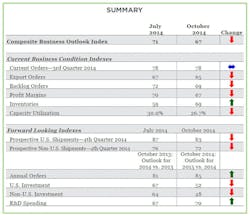While the manufacturing sector ended a nearly two-year upward trend due to a hiccup in the third quarter, industry group Manufacturers Alliance for Productivity and Innovation says that expansion will continue.
The MAPI Foundation Business Outlook reported that its October 2014 composite index slipped to 67 from 71 in the July 2014 survey, ending a run of six quarters of incremental improvement. Still, it marked the 20th consecutive quarter the index has remained above the threshold of 50, the dividing line separating contraction and expansion. The Composite Business Outlook Index is based on a weighted sum of the Prospective U.S. Shipments, Backlog Orders, Inventory, and Profit Margin Indexes.
“The third quarter was less robust than the second quarter for manufacturers but the current index levels nonetheless indicate expansion for the sector,” said Donald A. Norman, Ph.D., MAPI Foundation director of economic studies.
Current Business Condition Indexes
The Inventory Index, based on a comparison of inventory levels in the third quarter of 2014 with those in the third quarter of 2013, increased to 69 in October from 59 in July.
“Inventories are well above their level in the third quarter of 2013, thus raising the question as to whether inventories have been overbuilt,” Norman wrote.
The Current Orders Index, which compares orders in the third quarter of 2014 with the third quarter of 2013, remained at 78 from the previous report. The Export Orders Index, which compares anticipated exports in the third quarter of 2014 with those of one year prior, fell to 65 from 67.
The Profit Margin Index decreased to 67 in October from 70 in July and the Backlog Orders Index also dropped, from 72 to 69.
The Capacity Utilization Index, which measures the percentage of firms operating above 85% of capacity, fell to 26.7% in October from 30.0% in July. This index, which tends to be somewhat volatile, is below its long-term average of 32%.
Forward Looking Indexes
Forward looking indexes were mixed but still showed strength.
The Prospective U.S. Shipments Index, which reflects expectations for fourth quarter 2014 shipments compared with those in the fourth quarter of 2013, decreased to 83 from 87 in July. The Prospective Non-U.S. Shipments Index, which measures expectations for shipments abroad by foreign affiliates of U.S. firms for the same period, fell to 72 in October from 76 in the previous report. Both indexes are still performing at impressive levels.
The October report offers the initial look at expectations in a number of categories for 2015.
The Research and Development Spending Index, comparing anticipated spending in 2015 with 2014, improved to 70 from 67 in July. The Annual Orders Index, which is based on a comparison of expected orders for all of 2015 with orders in 2014, was 85, an increase from an already solid 81 in July.
The U.S. Investment Index, based on executives’ expectations regarding domestic capital investment for 2015 compared with 2014, declined significantly, to 52 from 67 in the previous survey. The Non-U.S. Investment Index, which forecasts investment abroad, also showed a major decline, dropping to 48 from 64.
“The decline in the composite index and most of the individual indexes point to a slowing of the momentum the sector had coming out of the second quarter. With the exception of U.S. and non-U.S. investment, however, the indexes remain at relatively high levels and point to continued growth,” Norman said.
Global Risks
Participants were queried on global risks to companies arising from conflicts and disease and what, if anything, firms are doing in response.
The region where respondents reported the greatest risk to operations is Ukraine and Russia. Other issues posing at least a slight risk to companies relate to Israel–Palestine, ISIS in Iraq, Syria, Ebola and terrorism in Africa, the military coup in Thailand, and the China–Japan island disputes.
In terms of geopolitical risks, 64% of the respondents indicated their company is minimizing cash and financial assets that could be “trapped.” Almost half report they are providing enhanced security for employees.




